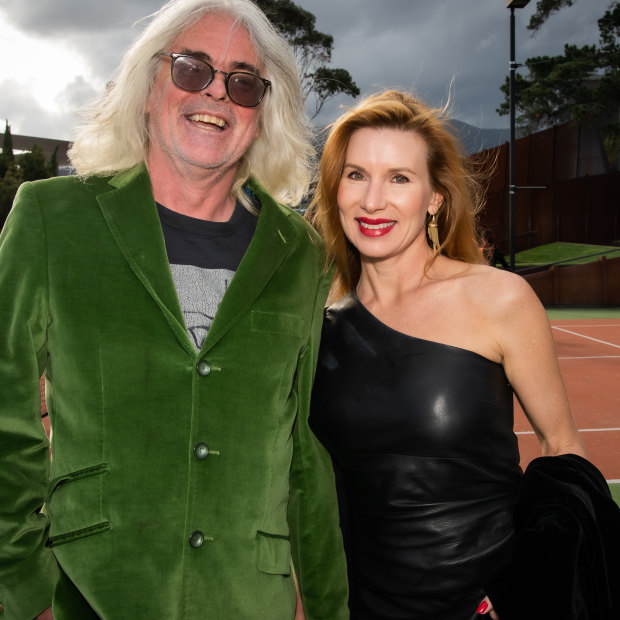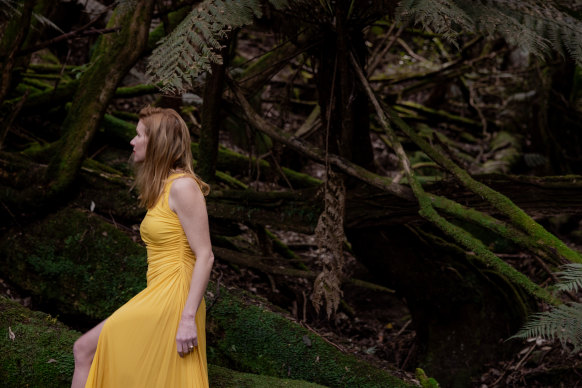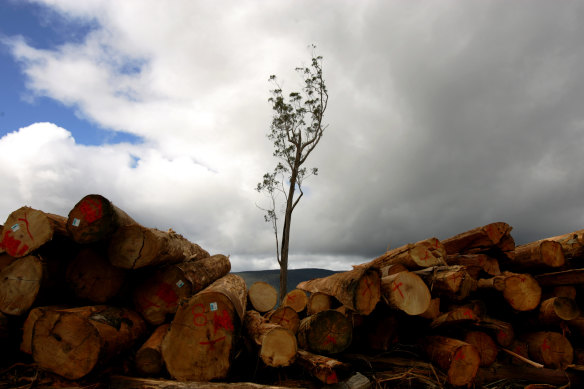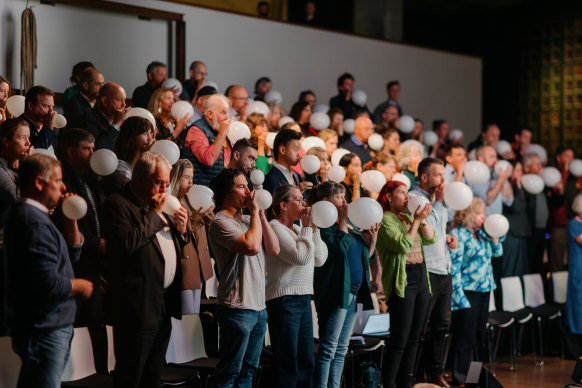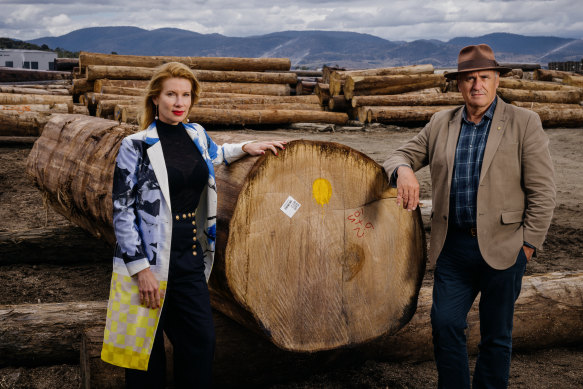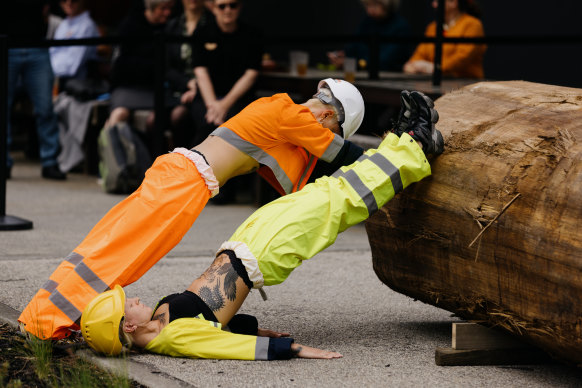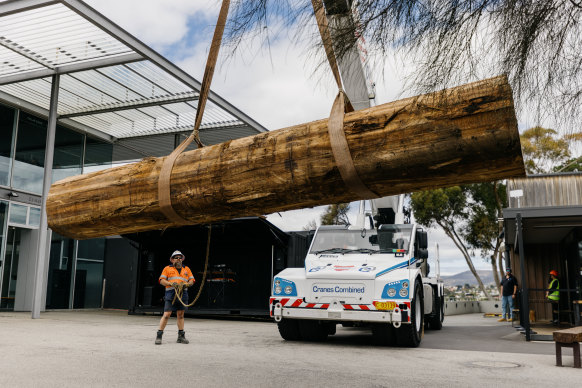By Nick O'Malley
Kirsha Kaechele with husband and Mona founder David Walsh.Credit: Amy Brown
Save articles for later
Add articles to your saved list and come back to them any time.
Rumours of the forest congress began to spread months before any details emerged. As soon as Kirsha Kaechele, the American wife of the Mona founder David Walsh, began to target people for the guest list, word got out that some sort of conference about the logging industry was to be held at the gallery.
People were immediately intrigued. Everyone is curious about Walsh and Kaechele, an artist and curator. They have deep and varied interests and even deeper pockets. They have real experience in hosting events and festivals – the winter festival Dark Mofo was an instant success, as is the summer Mona Foma – but less in the complicated and bleak politics of native forest logging in Tasmania.
Could Kirsha Kaechele really bring together such a disparate group?
Could Kaechele really bring together a substantial cross-section of industry players and activists, First Nations representatives and scientists after years of the so-called forest wars? Could she hold them together for long enough to talk?
People were sceptical. There had been previous attempts. Conservationists and the industry came to the so-called Salamanca Agreement in 1989 to take more land into national parks. It collapsed the following year. Three more forest agreements followed, each failing to bring about an end to the conflict.
Today the forests are drying out and burning more, timber shortages are looming and species like the swift parrot that depend on them are on the brink of extinction. Native forest logging on public land has been abandoned in WA and Victoria, yet the various sides of the debate in Tasmania can barely speak with one another.
I was invited to attend all of the sessions bar the small working groups. Other than that I could report what I saw and quote anyone happy to be quoted.
Tuesday morning
The group travels to Mona from downtown Hobart on Walsh’s high-speed ferry and is welcomed with a smoking ceremony. When the delegates assemble in a darkened room in the bowels of the museum, Jim Everett of the Plangermaireener clan gives a statement of country. He is fairly blunt about his view of the proceedings, which he planned to boycott until the last minute.
“It is not much good to have a talk fest like this and then walk away and say that we’ve done our part. So many times we have all done that.” In the end he decides it is best “that we all hear each other”.
Timber shortages are looming and some bird species that depend on them are on the brink of extinction.Credit: Steven Siewert
The godfather of Tasmanian environmentalism, Bob Brown, stands by his boycott, saying he would not sit along alongside people who would see him jailed for protest.
Instead he delivers a sermon which the Mona team illustrate with graphics of him meandering through a computer-simulated forest glade. Brown sees no scope for compromise on the need to end native forest logging, nor in his opposition to assessing the value of forests for potential carbon credits.
Among the delegates many agree, but others are unimpressed by the hardline stance.
“What happens to him if he breaks the law has nothing to do with us,” says one.
In her opening address Kaechele urges people to stick with the program, no matter how uncomfortable they might feel among people they have in the past only known over fraught political fault lines. Besides, she points out, there will be art, tequila and naked people.
Tuesday evening
At dusk, we gather for a reception at Government House, where Tasmania Governor Barbara Baker welcomes the group’s efforts to address a divisive issue “in the spirit of goodwill and co-operation”. Walsh toes at the ground like a bored schoolboy during the speeches.
David O’Byrne, a crossbencher and former Tasmanian Labor leader, who boasts the most meticulously groomed beard in Australian politics, tells me that no one but Walsh and Kaechele could even attempt a congress like this. No one else holds the trust and respect of such a broad cross-section of Tasmanian life. Let alone the resources.
Later we head outside into a cold drizzle for a tree planting ceremony. Baker plants one little eucalypt and Kaechele another. Then she stands by beaming as representatives of the Bob Brown Foundation and the timber industry plant a third. (“It was fine,” the activist Scott Jordan tells me later. “It’s not like they asked us to cut a tree down together.“)
I huddle under a fir tree with Walsh, who is grumbling cheerfully about the rain. “That’s some neat diplomacy there,” I say, indicating to the odd mob planting the third tree. “Ha!” he says, “You know what diplomacy is? F—ing lies!”
Much of the group kicks on to another arm of the Walsh empire, a “luxury dive bar” in Salamanca called Manky Sally’s. The mood is good, people are chatting. Professor Stuart Blanch of the World Wildlife Foundation swaps cards with Rob De Fegely, a board member of the NSW Forestry Corporation. There is tequila, but no nudity.
Wednesday
We are greeted at the wharf by a thrash band rather than a smoking ceremony. A trio of lightly clad but heavily made up grey-haired women dance wildly as one bloke wields both an electric guitar and a roaring chainsaw and another pounds drums.
Proceedings are delayed a little by the Danish artist Jeppe Hein who appears via Zoom and leads what Kaechele insists is an interactive art installation, but which seems suspiciously like a team-building exercise. We each inflate balloons upon which we are urged to write our desires. What follows is a group game of keepy-uppy. Jenny Brockie, the host, is reduced to schoolteacher mode, urging us to settle down for the day’s work to begin.
What follows are various debates over how the value of Tasmania’s forests might be best understood. Can the monetary value be measured at all? Is it appropriate to consider their value in the emerging carbon and biodiversity markets? What role, if any, should they have as an offset for other polluting industries?
Interactive art installation or team-building? One of the activities during the conference. Credit: Mona/Jesse Hunniford
The environmentalist and economist – and former treasury secretary – Dr Ken Henry argued that all these values should be measured and applied to Tasmania’s forests, where carbon can be sequestered securely in the long term in an economy regulated well enough for markets to trust the strength of the contracts.
This way, major emitters could be effectively taxed for polluting, with the revenue to be spent on restoring degraded nature.
“It seems to me that the best place to find credits of this quality is right here in the forests of Tasmania,” says Henry. “In three decades of public policy advising in Canberra, I’ve often heard people talking about the possibility of securing double dividends from innovative solutions to wicked problems. But I never once came across a double dividend of this quality.”
Kirsha Kaechele and Ken Henry in Tasmania. Credit: Mona/Jesse Hunniford
David Cross, chief executive of the free market think tank the Blueprint Institute, agrees. He uses the moment to launch a research paper suggesting the carbon stored in the forests would be worth $345 million in carbon markets, and the Tasmanian government would save $72 million if it paid out the industry and ceased native forest logging.
Cross argues that if no economic value is assigned to the forests, they will be considered to be of no value.
But Professor Andrew Macintosh of the ANU argues that many carbon credits issued in Australia to date are farcical, particularly those paid to landholders for allowing forests to regrow in arid landscapes where they will not grow.
Virginia Young, director of Wilderness Australia, tells Henry she believes that offsets serve only to allow polluters to keep polluting. Henry responds that in a world where all human activity causes carbon to be emitted, they are necessary.
“You either stop breathing, Virginia, or you offset your emissions.”
There is great interest from many in a new project to use drones to scan the entire state, creating a digital inventory of the entire forest.
As the discussion continues one participant, Dr Victor Steffensen, an Indigenous writer, filmmaker and traditional knowledge practitioner disagrees.
“You can’t put a value on Country,” he says. “A barrel of money runs out, you refill it. If you destroy Country it is gone.” Before colonisation the people who lived on Country were walking encyclopedias of it. Today, with AI and drones, we are growing “dumber”, and Country is suffering for it.
Timber miller Matthew Torenius lightens the mood, offering his view on the debate. “I’ve heard a lot about the viability of the industry here, and I feel like I am in a safe space to address it. If anyone knows anything about doing something that is not economically viable, it is David and Kirsha. You really are Tasmania’s parents. Can we have another $500 mil?”
As the conversation ends a voice comes out of the darkness. It is Michael O’Conner, the plain-talking chief of the manufacturing division of the CFMEU. He says Australia has a terrible history of looking after workers when industries are wound down. His union, he says, uses just one metric to test how well a mill closure has been managed. “We count the suicides.” After one mill in Victoria closed he lost two men in six weeks.
There’s a gasp and a silence in the room.
Later, O’Conner explains to me that when regional mills and mines shut it can have a far more profound impact than job losses in cities.
Communities can be broken apart and culture and identities shattered. “What if you lost three jobs in one family? What if you are the father of two boys who followed you into the mill?”
But he also says he has explained that to other sceptical audiences in the past and felt his words were shrugged off as a political talking point.
“It wasn’t like that at Mona. There was empathy.”
Wednesday lunchtime
It’s after lunch that the wheels start to come off.
As the delegates gathered again on the lawn above Mona, a performance begins. An opera singer wearing a cape made of emergency orange plastic mesh fencing begins to sing a lament. She is attended by a pair of dancers in cropped hi-vis gear. A crane appears bearing a gigantic freshly felled log, which is lowered gently to the ground.
Dancers in high-vis gear during a performance at the conference. Credit: Mona/Jesse Hunniford
At this point, according to the run sheet, Jim Everett was to have come forward and said a few words, but he can’t be seen. The organisers lose control of the mike.
Ruth Langford, a Yorta Yorta song woman and storyteller begins to mourn the tree with a terrible keening.
Other speakers, Indigenous and activist, speak to the forest’s destruction. The careful balance that has marked the proceedings so far – the “radical diplomacy” – falls out of kilter. There is a growing risk of a walk-out.
Making it all worse is that this was happening before local news crews, who have not been present throughout, but were invited to watch the tree ceremony. Kaechele tells reporters that the event is going well, but much of what they have just seen is “unscripted”.
“The log represents a lot of different things to different people. And so of course, you saw the raw emotion that our First Nations people feel around the clearing of those forests.”
A crane lowers a log to the ground in an unscripted moment. Credit: Mona/Jesse Hunniford
The delegates return to the darkness beneath where they are to be broken up into small groups to thrash out set topics.
Later, the Tasmanian Resources Minister Felix Ellis issues a press release saying he will no longer be attending the congress’s last session as planned due to the “behaviour of some attendees”.
“The Congress had the potential to host important and robust conversations about our sustainable forestry industry,” said the release.
“Instead, hardworking Tasmanians have endured heckling and abuse – this is totally unacceptable.”
Wednesday 7pm
Dinner is a hoe-down at The Hanging Gardens, another arm of Walsh’s Hobart empire, a sprawling nest of bars over a downtown block. I walk down a flight of stairs into an outdoor area under a vast permanent awning. A horse caked in a green substance of some sort gives me a long slow blink as it nuzzles at a keeper in its pen.
Perched around one table, a bunch of forestry industry types including Nick Steel, chief executive at the Tasmanian Forestry Products Association, are chatting over burgers (pulled venison or mushrooms) as a country band and dancers try to inject some life into the evening.
“It wasn’t what we expected. We were told that sort of thing would not be happening,” says Steel. But he denies the rumours that some have abandoned the talks entirely. They all plan to stick it through.
Thursday
At lunchtime I hover at one end of the log with some industry blokes. They cast a professional eye over the lumber and have little trouble assessing its monetary value, which they reckon would a little over $1500 at the mill door. Sawn into planks it might fetch up to $6000. A good furniture maker might craft 200 tables with it and charge $4000 or more for each.
We hover in the sun while the small groups report back.
One veteran of the forest wars says he is amazed so many people have stayed the course.
“There are contractors here who have been spat at and sworn at for doing their job. There are activists here who have been abused and arrested for trying to save the world.”
Weber says she is glad the Bob Brown Foundation delegation has held to its principles. It has not shifted its position calling for a total end to native forest logging, nor opposing the use of offsets or market mechanisms to attach new values to forests.
In the final session it is clear that there is no broad agreement on winding down native forest logging, though some see that its days may be numbered on public land. Nor is there consensus in building a new model for carbon or biodiversity offsets.
But there are startling advances. One group – which like all of them included representatives from across the pool of delegates – has unanimously agreed that the 300,000 hectares of the 350,000 the state has set aside for future possible logging should be returned to traditional owners for management.
“That in itself is momentous,” says one observer later. “That could not have happened without Mona. Imagine a group of politicians coming to that conclusion.”
Kaechele thanks everyone for staying on. “I know it was hard. I know you didn’t have to do this.” Walsh interrupts her from his seat. “Yes, apart from you, you had to do this,” she says with a laugh.
Heading up Mona’s circular stairs towards the light after the session, I run in to Jim Everett again. “I’m glad I came. I’m glad I stayed,” he says. “People here really listened. I’ve got to go and speak with some of the younger leaders now and tell them what happened.”
That night around a single table set for 120 in a void deep inside Mona, the mood starts to get loose. Wine and beer flow freely and cocktails are served in dams built into the table setting itself, which drifts from a desert diorama at one end, though fire to forest at the other.
Over three courses I sit variously with a beekeeper, a political fixer, Kaechele, a plantation logger, the head of Lark Distillery and for a time with Steve Whiteley of Sustainable Timber Tasmania. He tells me he has had conversations with people he never expected to speak with over the past three days. He says had never before heard some of the perspectives put by Indigenous delegates, and had conversations with people he never thought he’d speak with. He is glad he came.
We pile onto buses to head into the Odeon, yet another Walsh joint, in Hobart, where a party unfolds in a bar that looks like part of a Twin Peaks set. On the way in, Matt Torenius briefs a few of us on the deep family ties across the political and forest divide in Tasmania. It dawns on me that while deep enmities might be found in logging towns on the mainland, nowhere else is the industry so deeply woven into the tapestry of the whole state.
“There are two degrees of separation here, everyone knows a logger and everyone knows an activist,” someone observes.
Cocktails flow at the Odeon and Kaechele’s bacchanal begins. The highlight for Walsh and Kaechele is a performance by the Brooklyn-based feminist artist Narcissister. At one point, she pulls metre after metre of vines out of her vagina and I try to frame a photo of her act and Ken Henry. Henry throws me a stern look and I guiltily trouser my phone.
Later, Kaechele tells me the only aspect of the entire event she felt no nerves about were the artistic intrusions sprinkled through the program. “I’ve been putting art in front of people for a long time, I know how it draws people out.”
Nick O’Malley was a guest of Mona.
Get to the heart of what’s happening with climate change and the environment. Our fortnightly Environment newsletter brings you the news, the issues and the solutions. Sign up here.
Most Viewed in Environment
Source: Read Full Article
